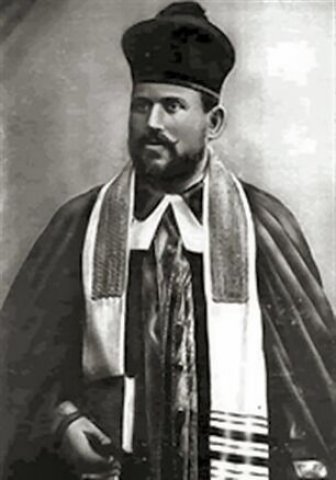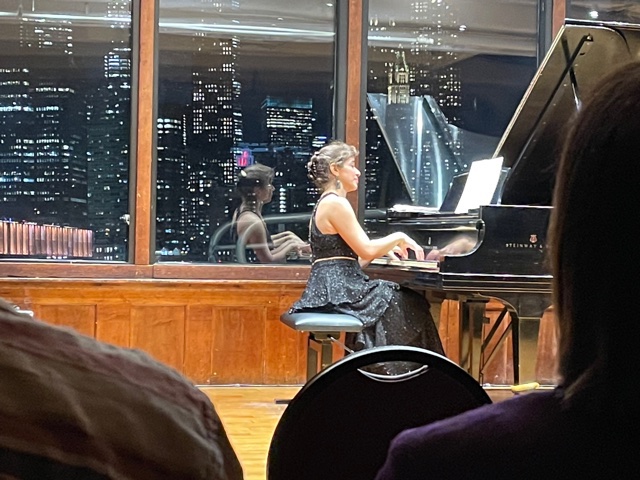Inna Faliks at The Barge
Generational Response Moves Beautiful Music to the Present
By: Susan Hall - Dec 22, 2021
Inna Faliks is not only a pianist of the highest order. She programs to reveal new insights into the music she performs. She is especially striking as a commissioner of new music.
Voices by Ljova opened her portion of a concert on The Barge in New York. It is a triptych for piano and historical recordings. When Ljova received the commission, he was consumed by the idea of returning Faliks to her native home, Odessa. He writes: “I knew that Inna was born in Odessa, the place where my great-grandparents were summarily executed in 1941 – but I had no specific reason, other than curiosity, that led me to recorded collections by celebrated Cantors of the Golden Age, and in turn to the voice of Gershon Sirota.”
Voices consists of three parts. Faliks performs a prelude which features fragments of the recorded melody, accompanied by a halting pattern comprised of a falling and rising minor arpeggios. After the climax, Faliks becomes an accompanist at a synagogue, where Gershon Sirota is chanting prayers for the Jewish New Year.
This mix of the music of a cantor, captured over a hundred years ago, and the present pianist fits so perfectly that it hardly seems a mix of media. The piano is the stage. Faliks’ soft rolling notes and her articulation of the melodies of the old Jewish faith (made familiar today in the intervals and harmonics of (West Side Story) introduce us to the world she comes from.
The Sirota movement incorporates a recording made by cantor Gershon Sirota and choir in Warsaw in 1908. Often referred to as “The Jewish Caruso”, Gershon Sirota was born in Ukraine and served as cantor in Odessa, Vilnius, and then Warsaw, where he perished in the Warsaw.
Sirota’s recording provides a vivid sense of the extraordinary power and expressive range of his voice. Like Faliks' performance, it is warm and penetrating, and capable of extraordinary dramatic contrasts. The power of his singing resulted from vocal gestures and ornaments that are central to the East European cantorial tradition, which includes not only the traditional modal patterns, but also attacks and glissandos, blended pitches (singing between the standard chromatic pitches), trills and turns, sudden dynamic contrasts, and a distinctive use of highly elaborate coloratura in the service of text and affective expression. These very phrases describe the pianist.
An old folk dance, Alter Zhok, performed by a solo clarinetist, offered the composer a melody rooted in an odd rhythm that combines with a joyful passage bridging the voices of Sirota and Fraydele Oysher, a woman cantor. “In an attempt to balance out a set of three pieces to complete Voices, I wanted to find recordings of Jewish cantorial music by women, " Ljova writes. "When I came across this recording of the celebrated Yiddish actress and singer Fraydele Oysher from 1953, I could not get it out of my mind – the voice, so beautifully flowing, the seamlessly shifting tonalities — I would listen to it over and over. The text of the prayer, 'Ov-Harachamim', written around the 12th century, commemorates the destruction of the Ashkenazi communities around the Rhine River by Christian crusaders during the First Crusade. The text of this prayer could also be a fitting memorial for the unforgettable voices of Cantor Sirota, the anonymous clarinettist of Alter(ed) Zhok, and Fraydele Oysher.”
Faliks interprets like a conductor. She shows us lines and phrases as they interconnect, cross and diverge. She uses her exceptionally large hands to promenade on the keyboard. Wrists are held high, with her fingers high stepping at an almost right angle. This impedes the speed when she wants it not a sou. She can create an unusual lightness of tone as well as crashing thunder.
Faliks' commissioned miniatures based on the Bagatelles of Beethoven and Ravel's Gaspard de la Nuit bring us to another place. Composers respond to the Beethoven each in their own way. Beethoven as an afterthought is an odd idea. Faliks plays the original after the response. This is like uncovering layers in a painting. The top layer is the new work, in this case composer’s response to the underlying Bagatelle. Some cover the original. Others let Beethoven peak through phrases. We want to lean in and listen more carefully as each work is revealed.
Billy Childs’ take on Scarbo from Gaspard de la Nuit is wild. He turns the rushing passages from Ravel into the fearful flight of a black man. Never as Faliks performs in a whirlwind of fingers and notes do we lose either the beauty of the urgency or the black man’s plight.
The concert opened with a premiere of George Meyer’s Duo for Violin and Viola. The composer performed on viola Emma Frucht was on violin. These superb artists gave us a charming work that had the slight aroma of a ‘ho down.
This program took place on The Barge, one of New York’s most charming venues. You rock on the boat as you watch perfumers reflected in the boat’s windows. Boats pass by outside, traveling up and down the East River. The Wall Street skyline shimmers in the background. A welcome way to end a difficult year. Live music.




